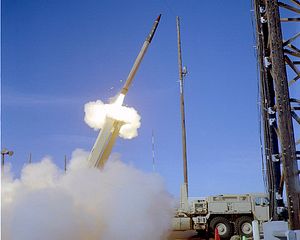The Rebalance authors Mercy Kuo and Angie Tang regularly engage subject-matter experts, policy practitioners and strategic thinkers across the globe for their diverse insights into the U.S. rebalance to Asia. This conversation with Mark Fitzpatrick – Executive Director of the Institute of International Strategic Studies (IISS) – U.S., who previously served 26 years at the U.S. Department of State, was a founding member of the EU Non-Proliferation Consortium, and is the author of Asia’s Latent Nuclear Powers: Japan, South Korea and Taiwan, Overcoming Pakistan’s Nuclear Dangers and The Iranian Nuclear Crisis: Avoiding worst-case outcomes – is the 34th in “The Rebalance Insight Series.”
Identify key forces and players impacting Northeast Asia’s nuclear arena.
Northeast Asia has seen the emergence of three nuclear-armed states. The USSR first tested an A-bomb in 1949, China in 1964 and North Korea in 2006. Each case was a surprise, and each posed a serious threat to Japan, in particular. Under political science theory, Tokyo thus had a repeated motivation to seek a nuclear equalizer, but it was always able to rely instead on the security guarantee provided by the United States. Ditto with Seoul, regarding the threat it faced from Pyongyang. In fact, South Korea sought nuclear weapons in the 1970s, as did Taiwan for two decades because of the existential threat from mainland China. The U.S. stopped both of them, using its alliance leverage and intelligence assets. Today, Japan, South Korea and Taiwan are staunch adherents to the non-proliferation regime, but this stance rests heavily on the credibility of U.S. extended deterrence.
Explain the strategic calculus of Japan, South Korea and Taiwan as Asia’s latent nuclear powers and implications for Asia’s security architecture.
Japan, South Korea and Taiwan are latent nuclear powers in that their advanced nuclear energy programs and rocket technologies provide capabilities that could be applied to weapons development. If judged necessary for national survival, they could build nuclear weapons in perhaps two years – or less in Japan’s case because it already possesses uranium enrichment and plutonium reprocessing technologies. Beyond latency, Japan employs a quasi-hedging strategy, which is defined as latency with intent. In Japan’s case, the hedging is “quasi” because the nuclear capabilities were developed primarily for economic reasons. Nuclear hedging was a secondary purpose. Over the years, Japanese officials have often noted that the facilities provide a future weapons option, although saying so publicly was also a means of creating diplomatic leverage with the U.S. to encourage Washington to strengthen its security guarantees. Many South Koreans want the same reprocessing and enrichment capabilities for a sense of equality with Japan and to provide a nuclear hedge vis-à-vis North Korea. Taiwan is abandoning nuclear power altogether and no longer talks about a nuclear hedge. But it probably keeps blueprints for the old weapons facilities in a cupboard somewhere.
What are the plausible regional security consequences of a U.S.-ROK agreement to deploy Terminal High Altitude Area Defense (THAAD) missile defense in South Korea?
Adding THAAD system to its missile defenses would provide a greater ability to defend South Korea against a North Korea nuclear missile attack. The defense would not be sufficient if North Korea launched a large number of missiles, but the North has a limited number of launchers and air crews. The THAAD radar would also help defend the U.S. homeland against a future North Korean ICBM threat. THAAD thus strengthens “deterrence by denial.” If missile defense prevents North Korea from being able to hit U.S. cities, then South Koreans can stop worrying whether the United States would be willing to trade Seattle for Seoul – the latest version of the decoupling question that De Gaulle first posed in the 1950s about U.S. willingness to trade New York for Paris.
What are the pros and cons of China’s taking a more forward-leaning leadership role in restraining North Korea’s nuclear ambitions?
China’s willingness to slap tough sanctions on North Korea reflected a belated realization that the repercussions of North Korea’s nuclear and missile tests are undermining Beijing’s own sense of security. South Korea’s decision to discuss THAAD deployment with the United States over Beijing’s strongly voiced objections was a serious blow. The strengthened triangular defense relationship among Japan, South Korea and the United States also shows that Beijing’s efforts to woo Seoul away from Washington are not working. China’s willingness actually to carry out the sanctions it agreed to on paper will be the most decisive factor in the degree of pressure North Korea will feel. If it works to constrain Pyongyang, President Xi Jinping should be awarded the Nobel Prize. North Korea rarely reacts well when cornered, however, so it must be offered positive incentives as well.
How should the next U.S. president bolster U.S. nuclear policy toward Asia, and what would be effective strategic messaging to regional powers?
Non-proliferation in Northeast Asia depends foremost on the credibility of U.S. deterrence. The next president must maintain this credibility. Donald Trump’s disparaging comments about Japan and South Korea have already undermined the confidence our allies have in our future willingness to come to their defense. One young Japanese official told me Trump’s insults made her think Japan might indeed need to consider having its own nuclear weapons. Obama’s pivot to East Asia, which extended a similar posture of the George W. Bush administration, should be continued, even if the new president wants to rename it with a new slogan. So, too, the senior-level consultative mechanisms on nuclear deterrence that have been established with Japan and South Korea.
Finally, it will be important for policymakers not to signal any de-prioritization of non-proliferation. When Vice President Dick Cheney and other influential Washington figures warned in the early part of the century that Pyongyang’s nuclear pursuit could prompt Japan’s nuclearization, it gave A-bomb proponents there a false impression that the U.S. would welcome this development. Playing the “Japan card” in this fashion would risk becoming a self-fulfilling prophecy by implying tacit approval.

































